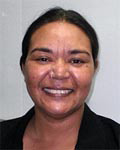Context
Human swine influenza (influenza A H1N109) has resulted in the first pandemic of the 21st Century. The symptoms of human swine influenza are similar to seasonal influenza and include: fever, cough, fatigue, myalgia, pharyngitis, chills, dyspnoea, coryza and headache. Complications include pneumonia, and even death in severe cases1.
Influenza is principally transmitted through respiratory droplets from a symptomatic individual. Until a vaccine becomes available, it is necessary to increase community infection control measures to limit transmission. Social distancing through limiting community activities has also been advocated.
The Australian Health Management Plan for Pandemic Influenza 20082 was prepared to protect all Australians and reduce the impact of a pandemic on social function and the economy. Recent experience suggests that control measures may be imposed on all communities, including rural and remote Aboriginal communities, in a 'one size fits all' approach. It is suspected that certain advocated strategies were not adapted or informed by Aboriginal voices.
During the pandemic of 1918-1919, Australian Indigenous populations were severely affected with a mortality rate approaching 50% in some communities3. In contrast, the mortality rate in Australia overall was less than 0.4%4. Social, ecological and geographical factors, as well as increased prevalence of co-morbidities, may provide an explanation for the disproportionately high mortality rates in Aboriginal communities.
H1N109 notifications indicate that Indigenous people are over-represented in the Australian cases (current at 6 August 2009). Statistics indicate that Indigenous people are approximately five times more likely than non-Indigenous Australians to be hospitalised for swine influenza and a similar proportion required intensive care treatment5.
Other countries have also found higher risks of severe disease in Indigenous people groups, for example the First Nations of Canada, and this has led to calls for close planning with Aboriginal people in response to these risks6.
Quarantine and isolation are public health measures that were used in the early response to H1N109. Although the mainstream Australian community has indicated support for these containment strategies7, there is no evidence that the measures have been developed in respectful negotiation with Indigenous communities.
In northern New South Wales (NSW) a shared understanding of the threats of pandemic influenza has been developing since 2006. In a pilot project conducted during 2008 under the auspices of the Hunter New England (HNE) Aboriginal Health Partnership - collaboration between the Area Health Service and all Aboriginal Community Controlled Health Services (ACCHS) - a focus group identified many difficulties posed by the national containment strategy in Indigenous communities8.
Issue
The purpose of the current work was to consult Aboriginal communities in response to the rapidly emerging H1N109 pandemic, and further develop understanding in health services and Aboriginal communities about appropriate and culturally safer ways to reduce the risk of influenza in communities. Measures identified in partnership to reduce the risk to individuals and community were then implemented.
The HNE Aboriginal Health Partnership encouraged consultation with communities served by the NSW ACCHS of Awabakal (Newcastle), Armajun (Inverell), Armidale, Biripi (Taree), Tamworth and Tobwabba (Forster). Community groups, including Lands Councils, Elders groups, and playgroups, Aboriginal health service staff and ACCHS Board members participated in the consultation. Input was also encouraged from the broader local Aboriginal community by email distribution of the consultation paper to key informants. Key stakeholders in these communities identified by the ACCHS and key informants were approached to input into the influenza consultation.
Typically the consultation focus group discussions took place in the community during normal activities, and were facilitated by two team members. The team provided input about the nature of influenza, its transmission, and the evolving pandemic. The community representatives were then encouraged to identify potential issues before further discussion was facilitated to allow identification of possible solutions.
The initial phase of the consultation took place over a 3 week period leading up to the National Aboriginal and Islander Days Of Celebration 2009 when many community events were scheduled. The consultation occurred during the 'contain' and early 'protect' phases of the Australian pandemic response. The consultation focused on reducing the risk of influenza at home and at community gatherings such as funerals; and providing access to health services. Scenarios in each of these focus areas were used to seed the conversations. The scenarios were constructed by the project team and trialled with Aboriginal health staff prior to field use. Examples of scenarios used include:
When a person has the new influenza strain everyone who lives in the house with the person will need to stay home and go onto influenza medication. There are all sorts of challenges with doing this; one of them is working out who lives in the household. Health services often think from a non-Aboriginal way instead of an Aboriginal way, so need a better process for talking with households or communities.
Or
If a family member comes and stays at a home that is in home isolation they will be at an increased risk of getting the disease. People coming to stay will either have to find somewhere else to stay or have to also go into quarantine and go onto the influenza medication.
As a starting point for the conversation people were asked:
What do you see as the main problems in this scenario? What could be done to work through these issues to help reduce risk of influenza in the community?
Field notes were recorded during these focus groups discussions. Themes from the consultation were identified by the project team in consultation with the HNE Aboriginal Health Partnership.
The consultation took the form of participatory action research (PAR), a research process used to initiate positive change, not simply to investigate an issue. The research process is based on the equal and collaborative involvement of the community in which the issue is located9-14 and allows Indigenous people to determine and control the research. PAR is based on a continuous research cycle of planning, action, observation and reflection to ensure that the recipients of the planned change are involved at every stage of the research, from the definition of the 'problem' to the implementation of a 'solution'.
Lessons learned
During the period 15 June-17 July 2009, 19 community groups from across the area participated in the consultation. In addition, a small number of individuals provided written input or phoned through with their thoughts on the consultation issues.
Five issue theme areas and a number of potential solutions emerged from the conversations:
- Local resource person
- Clear communication
- Access to health services
- Households and funerals
- Social and community support issues.
'Go to' (local contact) persons
The importance of having local people who are well informed and can advise on what to do in the event of an infectious disease incident, was expressed in every conversation with community groups. Having a local person meant that people in the community would have someone they could trust and could access easily. They were much less likely to contact someone from another community or area with whom they were not familiar. The local person would need training and support from the health service to meet this need. When asked about who these local contacts should be, most people identified Aboriginal health workers and ACCHS staff as the best 'go to' people.
Clear communication
Every focus group emphasised the need for clear communication with each community. Information was required in a clear and simple format, while demonstrating respect for the local culture. Specifically, people wanted to know what symptoms of illness they should be alert to and what they should do in the event of these symptoms appearing. Aboriginal radio programs and newsletters from Aboriginal organisations with locally made announcements were considered necessary if the messages were to be successful. Written information, such as posters and pamphlets with key messages, was considered helpful but needed to be supported by local people with photos or quotes to illustrate that these messages were supported by local, trusted people.
Groups consulted identified the need for specific information for particular risk groups, such as pregnant mothers and their babies.
Each community consulted indicated that conversations at community level were very important in sharing understanding.
Access to health services
Key informants consulted expressed their concern about their community's access to health services during a pandemic. Many people indicated already having trouble having their health needs met and felt that if the system was under more pressure this might mean it would be even more difficult to access health services. They expressed the need for clear guidance as to the particular service that was most appropriate: ACCHS, GPs or the hospital. After-hours access was considered a particular problem due to safety concerns related to past experiences. People felt discriminated against and that their needs were ignored. Having extended hours or clinics available on weekends through ACCHSs, specific GPs or clinics was considered a potential alternative.
Transport to health services was also identified as posing problems in all areas because many community members relied on a few drivers and only a few registered cars to transport them to health services. The drivers were considered very important people who needed to be protected from influenza. Suggestions included making sure that masks were available for the main drivers providing transport to health services, and to consider opening car windows.
Access to appropriate medications, particularly TamifluTM suspension, was raised as an important issue due to distance to hospitals. It was suggested that TamifluTM suspension should be kept at local ACCHSs and by GPs who support Aboriginal communities.
Households and funerals
In the focus group consultations people talked about large social gatherings, such as funerals and cultural celebrations, and the risk these posed for infection spread. Hand-wash or hand gel supplies were considered necessary for community events, with local contacts such as Aboriginal health workers being available to demonstrate to attendees how these should be used. The health services may have a role in supporting this prevention strategy by providing the products and training in their use at gatherings.
In each area key informants and groups reported that many households do not have tissues because these were too expensive and therefore not generally used. As a result the message about using tissues needs to be changed.
Masks were considered a possible option by some respondents but these would be particularly acceptable if provided in Aboriginal colours. Some respondents indicated that masks would not be used.
For funerals and other important family gatherings, the community members consulted indicated that people who are sick were still very likely to attend. When asked how infection might be reduced during these events, focus groups suggested that standing back from the others would be acceptable as long as it was considered to be a sign of respect and not disrespect. Elders could provide this interpretation for the community if they were provided with this information and support by Aboriginal health workers before the funeral.
When asked what the person sick with influenza should do at funerals and other family gatherings, some suggested not kissing, not hugging and not handshaking but this was not supported by others during the consultation.
Concern was expressed in each community about the risks for pregnant women, breastfeeding mothers and the risks for young children and Elders with pandemic influenza. These special groups in the community were felt to be very important. Further discussions are needed to determine appropriate measures for reducing the risk of pandemic influenza in these groups.
Preventing infection at home was considered challenging by each focus group, because many houses had large numbers of inhabitants, with inadequate bathrooms and bedrooms, and limited space. The presence of many visitors and extended family made limiting infection transmission difficult. Further discussion is clearly needed to develop acceptable and effective strategies.
Social and community support issues
Some people talked about the impact of influenza on other aspects of their lives. There was concern about being absent from work due to illness and not being paid because of casual employment status. Guidance is required from CentreLink (the social security agency), and key people in the community should be consulted for accurate information on addressing this concern.
Concern was also expressed about how to obtain a medical certificate if someone was sick at home and was not able to see a doctor. One suggestion was that, where necessary, the ACCHS nurses could write isolation certificates.
Conclusion
Influenza pandemics are a serious threat to the health and social functioning of Aboriginal communities. Measures to reduce the risk of influenza in communities need to be developed with communities to maximise their acceptance. The process of engagement and ongoing respectful consultation with communities is critical to identifying effective and culturally acceptable strategies. These understandings will now be used as the foundation for community PAR in northern NSW, North Queensland and the Kimberly areas of Australia.
Acknowledgements
The authors acknowledge the traditional owners of the land, Elders past and present of the communities who took part in this project. The authors are grateful to community key informants who generously shared with us their concerns and ideas about pandemic influenza, particularly the Aboriginal Community Controlled Health Services at Armidale, Forster, Inverell, Newcastle, Tamworth and Taree.
References
1. Novel Swine-Origin Influenza A (H1N1) Virus Investigation Team. Emergence of a novel swine-origin influenza A (H1N1) virus in humans. New England Journal of Medicine 2009; 360: 2605-2615.
2. Commonwealth of Australia. Australian Health Management Plan for Pandemic Influenza 2008. Canberra, ACT: Department Health & Ageing, 2008.
3. Cleland Burton J. Disease among the Australian Aborigines. Journal of Tropical Medicine and Hygiene 1928; 6: 65.
4. Curson P, McCracken K. An Australian perspective of the 1918-1919 influenza pandemic. NSW Public Health Bulletin 2006; 17: 103-107.
5. Australian Government Department of Health and Ageing. Australian influenza surveillance 2009. (Online) 2009. Available: http://www.healthemergency.gov.au/internet/healthemergency/publishing.nsf/Content/ozflucurrent.htm (Accessed 6 August 2009).
6. Groom AV, Jim C, LaRoque M, Mason C, McLaughlin J, Neel L et al. Pandemic influenza preparedness and vulnerable populations in tribal communities. American Journal of Public Health 2009; 99(S2): 2-8.
7. Eastwood K, Durrheim D, Francis JL, Tursan d'Espaignet E, Duncan S, Islam F et al. Knowledge about pandemic influenza and compliance with containment measures among Australians. Bulletin of the World Health Organisation 2009; 87(8): 565-644. Available: http://www.who.int/bulletin/volumes/87/8/08-060772/en/index.html (Accessed 1 September 2009).
8. Massey PD, Miller A, Durrheim DN, Speare R, Saggers S, Eastwood K. Pandemic influenza containment and the cultural and social context of Indigenous communities. Rural and Remote Health 9: 1179. (Online) 2009. Available: http://www.rrh.org.au/ (Accessed 1 September 2009).
9. Kemmis S, McTaggart R (Eds). The action research planner. Geelong, Vic: Deakin University, 1998.
10. Stringer E. Action research, 2nd edn. Thousand Oaks, CA: Sage, 1999.
11. O'Kane A, Tsey K. Towards a needs based mental health resource allocation and service development in rural and remote Australia. Australasian Psychiatry 2004; 12: 390-395.
12. Tsey K, Patterson D, Whiteside M, Baird L, Baird B. A micro analysis of a participatory action research process with a rural Aboriginal men's health group. Australian Journal of Primary Health 2004; 10: 64-71.
13. Tsey K, Wenitong M, McCalman J, Baird L, Patterson D, Baird B et al. A participatory action research process with a rural indigenous men's group: monitoring and reinforcing change. Australian Journal of Primary Health 2004; 10(3): 130-136.
14. Saggers S. Negotiating definitions of Indigenous participation in community development. In: R Eversole, J Martin (Eds.). Participation and governance in regional development Aldershot: Ashgate, 2005.





